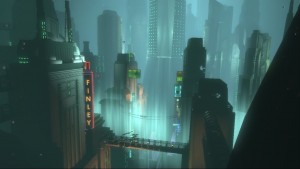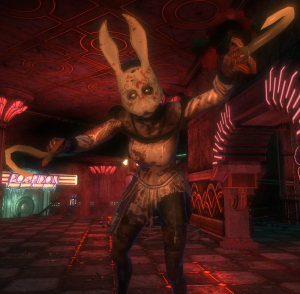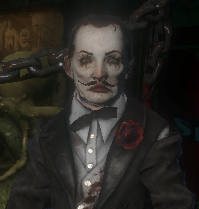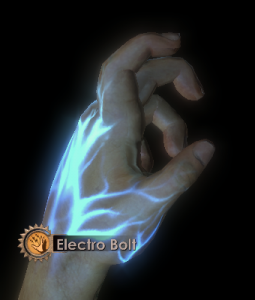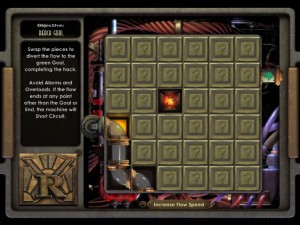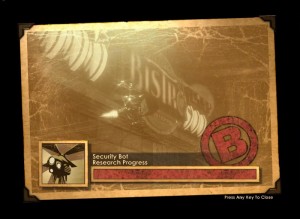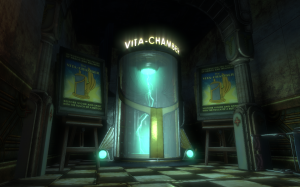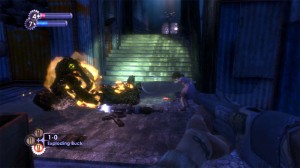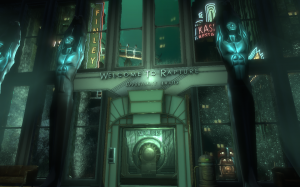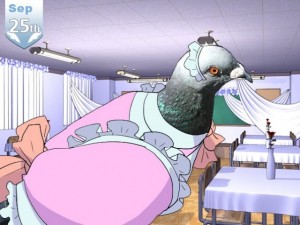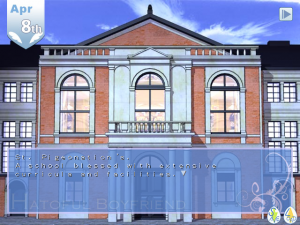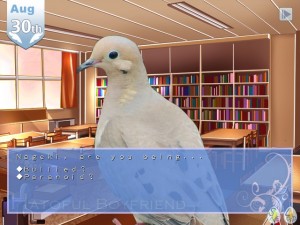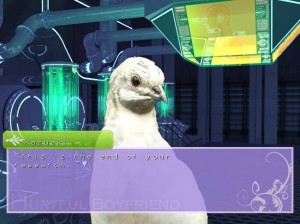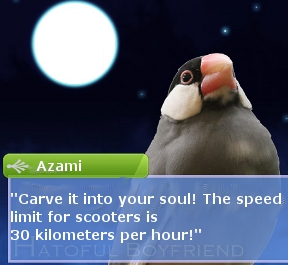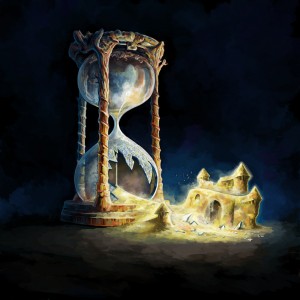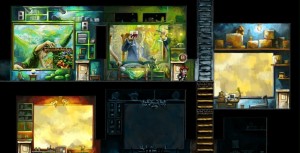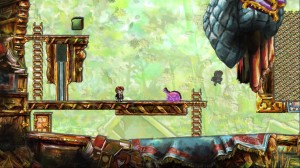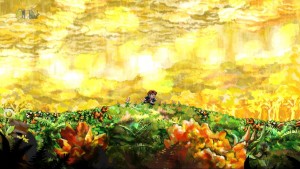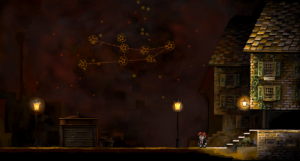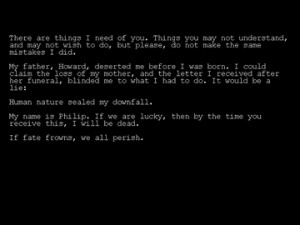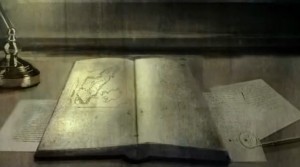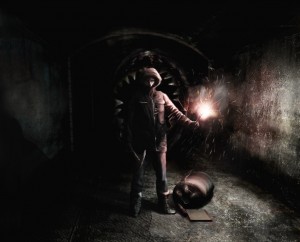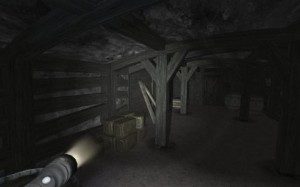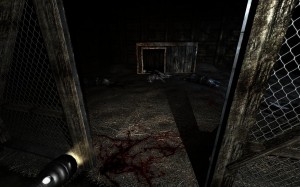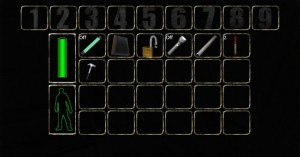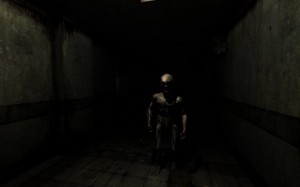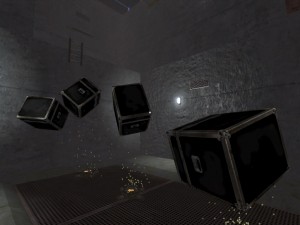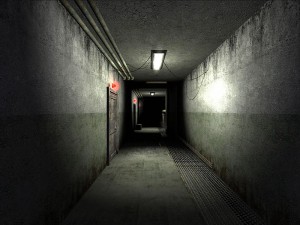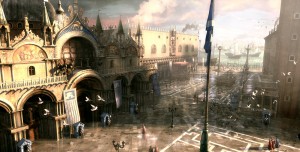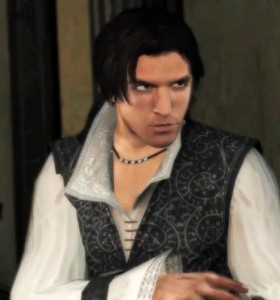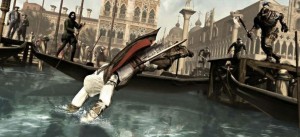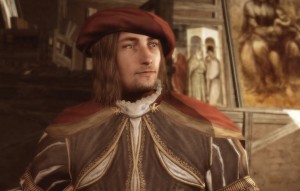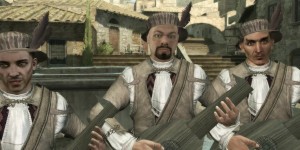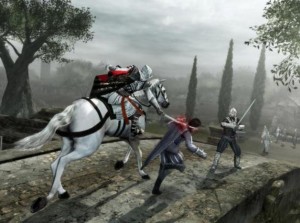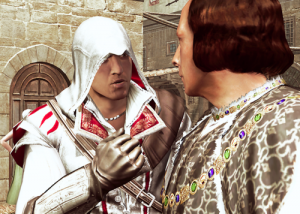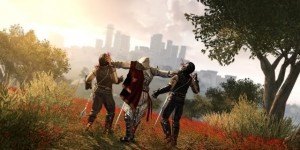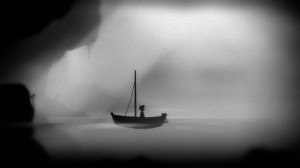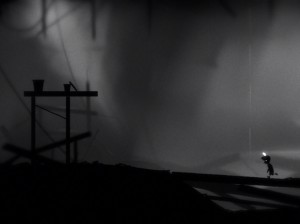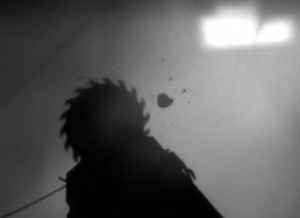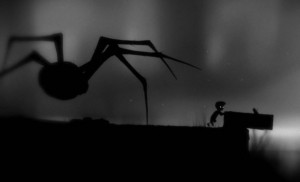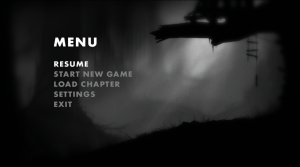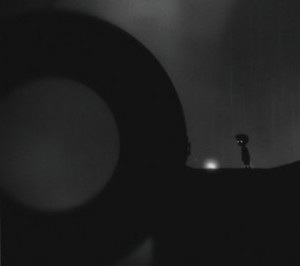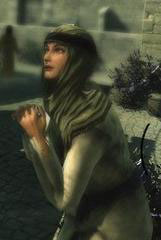The culprit: Portal (PC, Mac, PlayStation 3, Xbox 360)
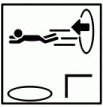 Sleeper hits are great. Not only are they a proof of inventiveness from game developers, who, despite not banking on commercial success, decide to try something new, but also a testimony to the players’ curiosity. In short: think outside the box, play outside the box. That’s how innovations occur.
Sleeper hits are great. Not only are they a proof of inventiveness from game developers, who, despite not banking on commercial success, decide to try something new, but also a testimony to the players’ curiosity. In short: think outside the box, play outside the box. That’s how innovations occur.
Portal was just one such sleeper hit. Released as part of The Orange Box package by Valve, it is set in the same universe as the Half-Life series, at some point in time between Half-Life and Half-Life 2. However, it’s not required to have played either one of those. Portal is a largely self-contained experience and works perfectly fine on its own. You’ll probably miss some references, but it’s nothing dramatic.
 The premise is a simple one: you are put in the metaphorical shoes (she’s actually barefoot, with only some leg springs for support) of Chell, a young woman who somehow ended up as a test subject in a strange facility named Aperture Science, all glass walls and pristine white surfaces. She is awoken by a robotic female voice, an AI which identifies herself as GLaDOS, and informs her that she must make her way through a series of test chambers, to ultimately be rewarded with “cake and grief counselling”. She then proceeds to instruct and advise her on getting through the tests…in her own way.
The premise is a simple one: you are put in the metaphorical shoes (she’s actually barefoot, with only some leg springs for support) of Chell, a young woman who somehow ended up as a test subject in a strange facility named Aperture Science, all glass walls and pristine white surfaces. She is awoken by a robotic female voice, an AI which identifies herself as GLaDOS, and informs her that she must make her way through a series of test chambers, to ultimately be rewarded with “cake and grief counselling”. She then proceeds to instruct and advise her on getting through the tests…in her own way.
 Chell’s available commands are pretty basic: she can crouch, jump, pick up objects or press switches. However, the core of the gameplay is the clever use of portals: oval-shaped holes which can be created on almost any flat surface with the help of a portal gun (or Handheld Portal Device), which Chell acquires a couple of rooms in. There are two types of portals: a blue one (primary) and an orange one (secondary). Chell can freely pass between them and reposition them at will, and if they’re not situated on the same plane, she’ll be reoriented head up in relation to the gravity upon exiting. The only thing she can’t do is fire a portal through another portal. The idea is straightforward, but the possibilities are endless, allowing for creative use of space to resolve what may at first appear to be impossible conundrums. You could have her put a portal on a wall and one on a ceiling through the door of a different room, for example. And don’t worry about falling from too high: as long as it’s a floor Chell is landing on, the leg springs will take care of it. This is a wonderfully adaptive system, and it wasn’t long before I found myself ‘thinking with portals’, as the advertising for the game puts it, and hopping my way through the various rooms with relative ease. I say ‘relative’ because, while it may be easy to figure out the principle behind a certain puzzle, the execution may require some fine-tuning, as well as some top-notch reflexes.
Chell’s available commands are pretty basic: she can crouch, jump, pick up objects or press switches. However, the core of the gameplay is the clever use of portals: oval-shaped holes which can be created on almost any flat surface with the help of a portal gun (or Handheld Portal Device), which Chell acquires a couple of rooms in. There are two types of portals: a blue one (primary) and an orange one (secondary). Chell can freely pass between them and reposition them at will, and if they’re not situated on the same plane, she’ll be reoriented head up in relation to the gravity upon exiting. The only thing she can’t do is fire a portal through another portal. The idea is straightforward, but the possibilities are endless, allowing for creative use of space to resolve what may at first appear to be impossible conundrums. You could have her put a portal on a wall and one on a ceiling through the door of a different room, for example. And don’t worry about falling from too high: as long as it’s a floor Chell is landing on, the leg springs will take care of it. This is a wonderfully adaptive system, and it wasn’t long before I found myself ‘thinking with portals’, as the advertising for the game puts it, and hopping my way through the various rooms with relative ease. I say ‘relative’ because, while it may be easy to figure out the principle behind a certain puzzle, the execution may require some fine-tuning, as well as some top-notch reflexes.
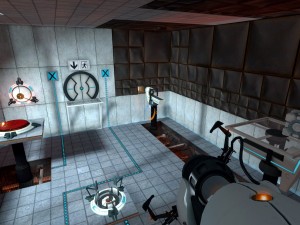 Of course, if that’s all there was to it, the game would be too easy. So it also presents Chell with impediments, such as moving platforms, timed switches, pools of acid, High Energy Pellets, which she’ll need to redirect, or Material Emancipation Grills, which will not only vaporise any solid object that’s not the portal gun (although they have also been known to ‘emancipate’ fillings and teeth…), but also reset any previously placed portals. Chell will also encounter sentry turrets, which, despite greeting her in disarmingly polite, childish-sounding voices (“hello, friend”) will attempt to shoot her on sight, intoning guilt-inducing messages such as “I don’t hate you” or “no hard feelings” when she destroys them. To counteract all these obstacles, Chell only
Of course, if that’s all there was to it, the game would be too easy. So it also presents Chell with impediments, such as moving platforms, timed switches, pools of acid, High Energy Pellets, which she’ll need to redirect, or Material Emancipation Grills, which will not only vaporise any solid object that’s not the portal gun (although they have also been known to ‘emancipate’ fillings and teeth…), but also reset any previously placed portals. Chell will also encounter sentry turrets, which, despite greeting her in disarmingly polite, childish-sounding voices (“hello, friend”) will attempt to shoot her on sight, intoning guilt-inducing messages such as “I don’t hate you” or “no hard feelings” when she destroys them. To counteract all these obstacles, Chell only 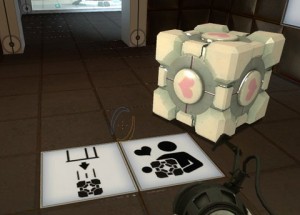 has her wits, her portal gun and Weighted Storage Cubes. These are…well, exactly what the description says: large cubes meant to be used as props for solving puzzles (usually by being placed on switches). Although one of them, the Companion Cube, designated by a large pink heart drawn on each of its sides, may come to hold a special place in Chell’s tribulations.
has her wits, her portal gun and Weighted Storage Cubes. These are…well, exactly what the description says: large cubes meant to be used as props for solving puzzles (usually by being placed on switches). Although one of them, the Companion Cube, designated by a large pink heart drawn on each of its sides, may come to hold a special place in Chell’s tribulations.
 Portal’s other major distinguishing feature is the delightfully quirky black humour pervading the game, the great majority of which is dispensed by GLaDOS, who also sings during the ending credits. On the surface, it sounds like she’s providing helpful advice. However, when you hear things like “while safety is one of many Enrichment Center goals, the Aperture Science High-Energy Pellets seen to the left of the chamber can and have caused permanent disabilities, such as vaporisation”, you may very well start asking yourself questions. This, alongside the friendly killer turrets, the sometimes less-than-reassuring instruction diagrams found at the beginning of each test chamber as well as the strange scribblings which start to crop up in hidden nooks towards the end of the game, all ends up creating a unique blend of the worrying and the hilarious.
Portal’s other major distinguishing feature is the delightfully quirky black humour pervading the game, the great majority of which is dispensed by GLaDOS, who also sings during the ending credits. On the surface, it sounds like she’s providing helpful advice. However, when you hear things like “while safety is one of many Enrichment Center goals, the Aperture Science High-Energy Pellets seen to the left of the chamber can and have caused permanent disabilities, such as vaporisation”, you may very well start asking yourself questions. This, alongside the friendly killer turrets, the sometimes less-than-reassuring instruction diagrams found at the beginning of each test chamber as well as the strange scribblings which start to crop up in hidden nooks towards the end of the game, all ends up creating a unique blend of the worrying and the hilarious.
The main portion of the storyline is fairly easily cleared, once you get the hang of the portal mechanics. However, you also have access to the Advanced Chambers and the Challenge Mode under the Bonus Maps heading of the main menu. The former are chambers 13 to 18 from the main game, redesigned to be more difficult. The Challenge Mode takes place in those same chambers (now identical to the main game), except with one of three restrictions: clear the chamber placing the least 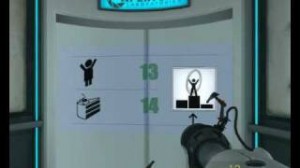 portals, taking the least steps or the least time. Each chamber has its own set limit for each of these categories (represented by a cake on the tally screen), reaching or beating which will grant you a gold medal. There are also limits for the silver medal and the bronze medal. And, of course, there are achievements/trophies involved. By order of difficulty, I’d say the “least portals” challenges are the easiest, while the “least time” ones are–and by far–the hardest, especially for people playing on a console. Moreover, folks on the Xbox 360 actually got their own version of the game, called Portal: Still Alive, which contains a whopping 14 additional test chambers.
portals, taking the least steps or the least time. Each chamber has its own set limit for each of these categories (represented by a cake on the tally screen), reaching or beating which will grant you a gold medal. There are also limits for the silver medal and the bronze medal. And, of course, there are achievements/trophies involved. By order of difficulty, I’d say the “least portals” challenges are the easiest, while the “least time” ones are–and by far–the hardest, especially for people playing on a console. Moreover, folks on the Xbox 360 actually got their own version of the game, called Portal: Still Alive, which contains a whopping 14 additional test chambers.
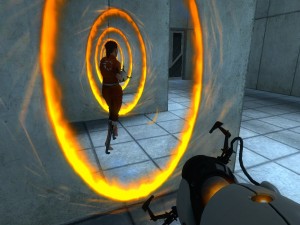 All in all, Portal is great fun. However, for the sake of providing some criticism, I must say that it’s a bit of a one-trick pony. There is an interesting backstory to the game (which has since been explored in a comic entitled Lab Rat and in the sequel, Portal 2), and GLaDOS may be a wellspring of repartee, but this can only go so far when, in point of fact, you’re being made to do the same thing over and over again. Fortunately, the game is rather short, so you won’t have time to get bored on your first time through. It does, however, mean that it suffers in the replayability department, since, apart from collecting hidden radios, it’s the same old show. Still, I won’t be a party-pooper: in spite of this, Portal remains one of the most original games released in the past decade, and the premise behind it is
All in all, Portal is great fun. However, for the sake of providing some criticism, I must say that it’s a bit of a one-trick pony. There is an interesting backstory to the game (which has since been explored in a comic entitled Lab Rat and in the sequel, Portal 2), and GLaDOS may be a wellspring of repartee, but this can only go so far when, in point of fact, you’re being made to do the same thing over and over again. Fortunately, the game is rather short, so you won’t have time to get bored on your first time through. It does, however, mean that it suffers in the replayability department, since, apart from collecting hidden radios, it’s the same old show. Still, I won’t be a party-pooper: in spite of this, Portal remains one of the most original games released in the past decade, and the premise behind it is  wonderfully inventive. GLaDOS has become a fan-favourite (for good reason), and chances are you’ve encountered the “cake is a lie” meme somewhere at least once. In short, give it a try. It’s a blast. Oh, and did you know you can donate one or all of your vital organs to the Aperture Science Self-Esteem Fund for Girls?
wonderfully inventive. GLaDOS has become a fan-favourite (for good reason), and chances are you’ve encountered the “cake is a lie” meme somewhere at least once. In short, give it a try. It’s a blast. Oh, and did you know you can donate one or all of your vital organs to the Aperture Science Self-Esteem Fund for Girls?

